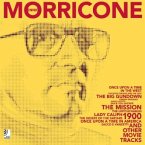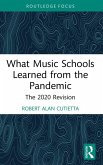Ari Contzius, Evan Feldman
Instrumental Music Education
Teaching with the Musical and Practical in Harmony
Ari Contzius, Evan Feldman
Instrumental Music Education
Teaching with the Musical and Practical in Harmony
- Gebundenes Buch
- Merkliste
- Auf die Merkliste
- Bewerten Bewerten
- Teilen
- Produkt teilen
- Produkterinnerung
- Produkterinnerung
Instrumental Music Education: Teaching with the Theoretical and Practical in Harmony, Fourth Edition, is intended for college instrumental music education majors studying to be band and orchestra directors at the elementary, middle school, and high school levels.
Andere Kunden interessierten sich auch für
![Ennio Morricone Ennio Morricone]() Sergio MiceliEnnio Morricone39,95 €
Sergio MiceliEnnio Morricone39,95 €![Luis Valdez Luis Valdez]() Jorge A. HuertaLuis Valdez165,99 €
Jorge A. HuertaLuis Valdez165,99 €![The Death of Hamlet The Death of Hamlet]() Amir KhanThe Death of Hamlet206,99 €
Amir KhanThe Death of Hamlet206,99 €![Researching the Creative and Cultural Industries Researching the Creative and Cultural Industries]() Simone WesnerResearching the Creative and Cultural Industries166,99 €
Simone WesnerResearching the Creative and Cultural Industries166,99 €![Maytime: A Play With Music In Four Acts Maytime: A Play With Music In Four Acts]() Sigmund RombergMaytime: A Play With Music In Four Acts35,99 €
Sigmund RombergMaytime: A Play With Music In Four Acts35,99 €![The First Oscar Hammerstein and New York's Golden Age of Theater and Music The First Oscar Hammerstein and New York's Golden Age of Theater and Music]() Adolph S. TomarsThe First Oscar Hammerstein and New York's Golden Age of Theater and Music56,99 €
Adolph S. TomarsThe First Oscar Hammerstein and New York's Golden Age of Theater and Music56,99 €![What Music Schools Learned from the Pandemic What Music Schools Learned from the Pandemic]() Robert CutiettaWhat Music Schools Learned from the Pandemic77,99 €
Robert CutiettaWhat Music Schools Learned from the Pandemic77,99 €-
-
-
Instrumental Music Education: Teaching with the Theoretical and Practical in Harmony, Fourth Edition, is intended for college instrumental music education majors studying to be band and orchestra directors at the elementary, middle school, and high school levels.
Hinweis: Dieser Artikel kann nur an eine deutsche Lieferadresse ausgeliefert werden.
Hinweis: Dieser Artikel kann nur an eine deutsche Lieferadresse ausgeliefert werden.
Produktdetails
- Produktdetails
- Verlag: Taylor & Francis Ltd
- Seitenzahl: 526
- Erscheinungstermin: 26. Juli 2024
- Englisch
- Abmessung: 280mm x 210mm
- Gewicht: 1170g
- ISBN-13: 9781032432076
- ISBN-10: 1032432071
- Artikelnr.: 70149003
- Herstellerkennzeichnung
- Libri GmbH
- Europaallee 1
- 36244 Bad Hersfeld
- 06621 890
- Verlag: Taylor & Francis Ltd
- Seitenzahl: 526
- Erscheinungstermin: 26. Juli 2024
- Englisch
- Abmessung: 280mm x 210mm
- Gewicht: 1170g
- ISBN-13: 9781032432076
- ISBN-10: 1032432071
- Artikelnr.: 70149003
- Herstellerkennzeichnung
- Libri GmbH
- Europaallee 1
- 36244 Bad Hersfeld
- 06621 890
Evan Feldman, DMA is Conductor of the Wind Ensemble and Professor of Music at the University of North Carolina at Chapel Hill. Ari Contzius is the Wind Ensemble Conductor at Washingtonville High School, Washingtonville, New York. Mitchell Lutch, DMA is Assistant Teaching Professor of Music and Concert Band Director at Worcester Polytechnic Institute, Worcester, MA. Katarzyna (Kasia) Bugaj is Associate Professor of String Music Education in the College of Music at The Florida State University in Tallahassee, Florida. William L. Lake, Jr., DMA is Director of Concert Bands at the Reva and Sid Dewberry Family School of Music at George Mason University.
Contents
Foreword
Preface
UNIT 1: THE PROCESS OF TEACHING INSTRUMENTAL MUSIC
Chapter 1: An Introduction to Sound-to-Symbol
Chapter 2: Teaching Rhythm and Rhythm Reading: Audiation, Pulse, Pattern,
and Meter
Chapter 3: Tonality, Melody, and Singing
Chapter 4: Teaching Improvisation and Composition
Chapter 5: The History of Instrumental Music Education and Its Philosophy:
A Brief Introduction
Chapter 6: Special Topics: Constructivism, Concept Attainment, and Direct
Instruction
UNIT 2: DIRECTING BANDS AND ORCHESTRAS
Chapter 7: Classroom Management
Chapter 8: Special Topics: Social and Emotional Learning in the Music
Classroom
Chapter 9: Curriculum, Assessment, and Grading
Chapter 10: Repertoire
Chapter 11: Special Topics: An Introduction to Culturally Responsive
Teaching
Chapter 12: Score Study
Chapter 13: On Conducting Technique
Chapter 14: Large Ensemble Set-Up
Chapter 15: Rehearsals
Chapter 16: Special Topics: Inclusion-Instrumental Music for Students with
Special Needs
Chapter 17: Intonation
Chapter 18: Directing Other Ensembles
Chapter 19: Recruiting, Organizing, and Starting the Band and Orchestra
Chapter 20: Sound-to-Symbol in the Beginning Instrumental Classroom
Chapter 21: String Pedagogy for Non-String Players
UNIT 3: ADMINISTRATIVE ISSUES
Chapter 22: Planning and Managing a Concert/Concert Etiquette
Chapter 23: Fundraising, Promotion, and Advocacy
Chapter 24: Communication
Chapter 25: The Music Budget
Chapter 26: Copyrights
Chapter 27: Managing Sound Levels: Protecting Your Ears and Those of Your
Students
Chapter 28: Special Topics: Leadership, Mentors, and Professional
Development
Chapter 29: The Job Search and Interview
Appendix: The Rehearsal Toolkit
Foreword
Preface
UNIT 1: THE PROCESS OF TEACHING INSTRUMENTAL MUSIC
Chapter 1: An Introduction to Sound-to-Symbol
Chapter 2: Teaching Rhythm and Rhythm Reading: Audiation, Pulse, Pattern,
and Meter
Chapter 3: Tonality, Melody, and Singing
Chapter 4: Teaching Improvisation and Composition
Chapter 5: The History of Instrumental Music Education and Its Philosophy:
A Brief Introduction
Chapter 6: Special Topics: Constructivism, Concept Attainment, and Direct
Instruction
UNIT 2: DIRECTING BANDS AND ORCHESTRAS
Chapter 7: Classroom Management
Chapter 8: Special Topics: Social and Emotional Learning in the Music
Classroom
Chapter 9: Curriculum, Assessment, and Grading
Chapter 10: Repertoire
Chapter 11: Special Topics: An Introduction to Culturally Responsive
Teaching
Chapter 12: Score Study
Chapter 13: On Conducting Technique
Chapter 14: Large Ensemble Set-Up
Chapter 15: Rehearsals
Chapter 16: Special Topics: Inclusion-Instrumental Music for Students with
Special Needs
Chapter 17: Intonation
Chapter 18: Directing Other Ensembles
Chapter 19: Recruiting, Organizing, and Starting the Band and Orchestra
Chapter 20: Sound-to-Symbol in the Beginning Instrumental Classroom
Chapter 21: String Pedagogy for Non-String Players
UNIT 3: ADMINISTRATIVE ISSUES
Chapter 22: Planning and Managing a Concert/Concert Etiquette
Chapter 23: Fundraising, Promotion, and Advocacy
Chapter 24: Communication
Chapter 25: The Music Budget
Chapter 26: Copyrights
Chapter 27: Managing Sound Levels: Protecting Your Ears and Those of Your
Students
Chapter 28: Special Topics: Leadership, Mentors, and Professional
Development
Chapter 29: The Job Search and Interview
Appendix: The Rehearsal Toolkit
Contents
Foreword
Preface
UNIT 1: THE PROCESS OF TEACHING INSTRUMENTAL MUSIC
Chapter 1: An Introduction to Sound-to-Symbol
Chapter 2: Teaching Rhythm and Rhythm Reading: Audiation, Pulse, Pattern,
and Meter
Chapter 3: Tonality, Melody, and Singing
Chapter 4: Teaching Improvisation and Composition
Chapter 5: The History of Instrumental Music Education and Its Philosophy:
A Brief Introduction
Chapter 6: Special Topics: Constructivism, Concept Attainment, and Direct
Instruction
UNIT 2: DIRECTING BANDS AND ORCHESTRAS
Chapter 7: Classroom Management
Chapter 8: Special Topics: Social and Emotional Learning in the Music
Classroom
Chapter 9: Curriculum, Assessment, and Grading
Chapter 10: Repertoire
Chapter 11: Special Topics: An Introduction to Culturally Responsive
Teaching
Chapter 12: Score Study
Chapter 13: On Conducting Technique
Chapter 14: Large Ensemble Set-Up
Chapter 15: Rehearsals
Chapter 16: Special Topics: Inclusion-Instrumental Music for Students with
Special Needs
Chapter 17: Intonation
Chapter 18: Directing Other Ensembles
Chapter 19: Recruiting, Organizing, and Starting the Band and Orchestra
Chapter 20: Sound-to-Symbol in the Beginning Instrumental Classroom
Chapter 21: String Pedagogy for Non-String Players
UNIT 3: ADMINISTRATIVE ISSUES
Chapter 22: Planning and Managing a Concert/Concert Etiquette
Chapter 23: Fundraising, Promotion, and Advocacy
Chapter 24: Communication
Chapter 25: The Music Budget
Chapter 26: Copyrights
Chapter 27: Managing Sound Levels: Protecting Your Ears and Those of Your
Students
Chapter 28: Special Topics: Leadership, Mentors, and Professional
Development
Chapter 29: The Job Search and Interview
Appendix: The Rehearsal Toolkit
Foreword
Preface
UNIT 1: THE PROCESS OF TEACHING INSTRUMENTAL MUSIC
Chapter 1: An Introduction to Sound-to-Symbol
Chapter 2: Teaching Rhythm and Rhythm Reading: Audiation, Pulse, Pattern,
and Meter
Chapter 3: Tonality, Melody, and Singing
Chapter 4: Teaching Improvisation and Composition
Chapter 5: The History of Instrumental Music Education and Its Philosophy:
A Brief Introduction
Chapter 6: Special Topics: Constructivism, Concept Attainment, and Direct
Instruction
UNIT 2: DIRECTING BANDS AND ORCHESTRAS
Chapter 7: Classroom Management
Chapter 8: Special Topics: Social and Emotional Learning in the Music
Classroom
Chapter 9: Curriculum, Assessment, and Grading
Chapter 10: Repertoire
Chapter 11: Special Topics: An Introduction to Culturally Responsive
Teaching
Chapter 12: Score Study
Chapter 13: On Conducting Technique
Chapter 14: Large Ensemble Set-Up
Chapter 15: Rehearsals
Chapter 16: Special Topics: Inclusion-Instrumental Music for Students with
Special Needs
Chapter 17: Intonation
Chapter 18: Directing Other Ensembles
Chapter 19: Recruiting, Organizing, and Starting the Band and Orchestra
Chapter 20: Sound-to-Symbol in the Beginning Instrumental Classroom
Chapter 21: String Pedagogy for Non-String Players
UNIT 3: ADMINISTRATIVE ISSUES
Chapter 22: Planning and Managing a Concert/Concert Etiquette
Chapter 23: Fundraising, Promotion, and Advocacy
Chapter 24: Communication
Chapter 25: The Music Budget
Chapter 26: Copyrights
Chapter 27: Managing Sound Levels: Protecting Your Ears and Those of Your
Students
Chapter 28: Special Topics: Leadership, Mentors, and Professional
Development
Chapter 29: The Job Search and Interview
Appendix: The Rehearsal Toolkit








